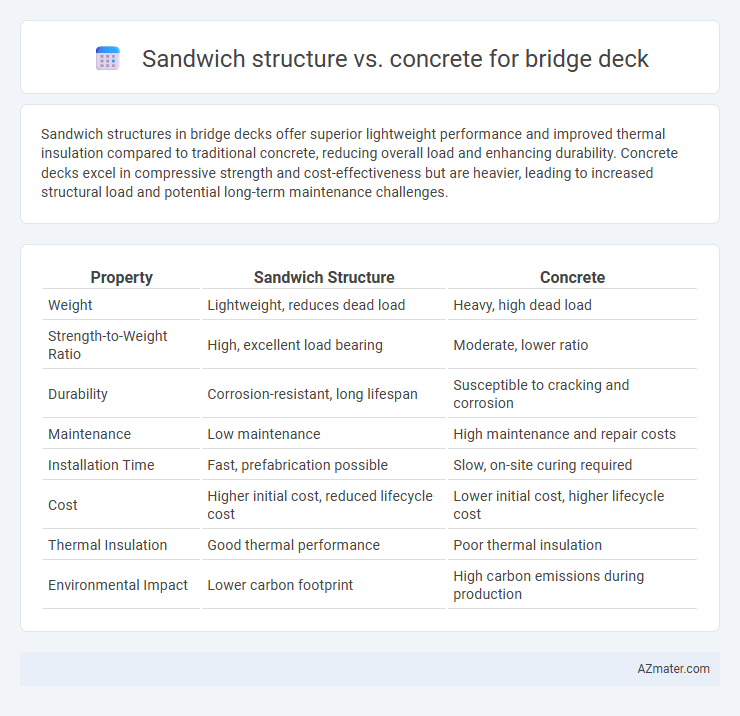Sandwich structures in bridge decks offer superior lightweight performance and improved thermal insulation compared to traditional concrete, reducing overall load and enhancing durability. Concrete decks excel in compressive strength and cost-effectiveness but are heavier, leading to increased structural load and potential long-term maintenance challenges.
Table of Comparison
| Property | Sandwich Structure | Concrete |
|---|---|---|
| Weight | Lightweight, reduces dead load | Heavy, high dead load |
| Strength-to-Weight Ratio | High, excellent load bearing | Moderate, lower ratio |
| Durability | Corrosion-resistant, long lifespan | Susceptible to cracking and corrosion |
| Maintenance | Low maintenance | High maintenance and repair costs |
| Installation Time | Fast, prefabrication possible | Slow, on-site curing required |
| Cost | Higher initial cost, reduced lifecycle cost | Lower initial cost, higher lifecycle cost |
| Thermal Insulation | Good thermal performance | Poor thermal insulation |
| Environmental Impact | Lower carbon footprint | High carbon emissions during production |
Introduction to Bridge Deck Materials
Sandwich structures for bridge decks utilize a lightweight core material, such as foam or honeycomb, bonded between two composite face sheets, offering high strength-to-weight ratios and excellent thermal insulation. Concrete, traditionally used in bridge decks, provides durability, compressive strength, and cost-effectiveness but results in heavier structures requiring more substantial substructures. Choosing between sandwich structures and concrete depends on factors like load-bearing requirements, maintenance considerations, environmental conditions, and construction timelines.
Overview of Sandwich Structure Systems
Sandwich structure systems for bridge decks consist of two strong outer layers bonded to a lightweight core, typically made of foam or honeycomb materials, providing high strength-to-weight ratios and excellent thermal insulation. These systems offer enhanced durability, reduced dead load, and improved resistance to corrosion compared to traditional concrete decks. The design flexibility and rapid installation capabilities make sandwich structures an increasingly popular alternative in modern bridge construction.
Concrete Bridge Decks: Traditional Approach
Concrete bridge decks, a traditional approach in bridge construction, are favored for their high compressive strength and durability under heavy loads and harsh environmental conditions. Their inherent mass provides excellent vibration damping and long service life, requiring relatively low maintenance. However, concrete decks tend to be heavier and can be more susceptible to cracking from temperature fluctuations compared to sandwich structure alternatives.
Comparative Analysis: Weight and Load Capacity
Sandwich structures for bridge decks typically offer a significant reduction in weight compared to traditional concrete decks, often achieving up to 50% lighter profiles due to their composite layers of foam core and fiber-reinforced skins. Despite the decreased weight, sandwich structures maintain high load-bearing capacity, with flexural strengths ranging between 30 to 50 MPa, suitable for medium to heavy vehicular traffic. Conversely, concrete decks provide superior compressive strength often above 40 MPa but contribute substantial dead load, impacting overall bridge design and necessitating stronger supporting elements.
Durability and Maintenance Considerations
Sandwich structures for bridge decks offer superior durability due to their corrosion-resistant composite materials and enhanced fatigue performance compared to traditional concrete decks. They require less frequent maintenance since the closed-cell core prevents moisture ingress, reducing risks of delamination and rusting of reinforcements. While concrete decks are prone to cracking and spalling from freeze-thaw cycles and chloride exposure, sandwich panels maintain structural integrity longer under harsh environmental conditions.
Thermal and Weather Performance
Sandwich structure bridge decks exhibit superior thermal insulation properties compared to traditional concrete, reducing heat transfer and minimizing thermal expansion and contraction, which enhances durability under fluctuating temperatures. Their composite layers provide better resistance to freeze-thaw cycles and moisture ingress, lowering the risk of cracking and surface spalling commonly observed in concrete decks. The enhanced weather performance of sandwich structures translates into extended service life and reduced maintenance costs in diverse climatic conditions.
Construction Time and Efficiency
Sandwich structures for bridge decks significantly reduce construction time due to their lightweight components and prefabrication capabilities, enabling faster installation compared to traditional concrete decks. The efficiency gains stem from minimized curing requirements and less formwork, which streamline the construction process and lower labor costs. In contrast, concrete decks require extended curing periods and substantial on-site labor, prolonging project timelines and increasing overall resource consumption.
Cost Comparison: Initial and Lifecycle Perspectives
Sandwich structures for bridge decks typically have higher initial costs due to advanced materials like composite cores and durable facings, but they offer reduced installation time and labor expenses. In contrast, concrete decks present lower upfront costs but incur higher maintenance and repair expenses over their lifecycle because of susceptibility to cracking, corrosion, and heavier structural demands. Lifecycle cost analysis often favors sandwich structures for long-term savings through enhanced durability, reduced maintenance, and extended service life despite their premium initial investment.
Case Studies: Real-World Applications
Case studies reveal sandwich structures in bridge decks offer superior durability and reduced weight compared to traditional concrete, enhancing load capacity and construction speed. For example, the Queensferry Crossing in Scotland uses a composite sandwich deck, resulting in a 30% weight reduction and improved thermal insulation. Concrete decks, exemplified by the Millau Viaduct in France, provide exceptional compressive strength but often require longer curing times and heavier support structures.
Future Trends in Bridge Deck Design
Future trends in bridge deck design emphasize lightweight, durable materials like sandwich structures to enhance load-bearing efficiency and reduce maintenance costs. Sandwich structures, consisting of composite face sheets and a core material, offer superior strength-to-weight ratios compared to traditional concrete decks, enabling longer spans and faster construction. Advances in materials science and structural health monitoring technologies further position sandwich decks as a sustainable, performance-driven alternative for next-generation bridges.

Infographic: Sandwich structure vs Concrete for Bridge deck
 azmater.com
azmater.com